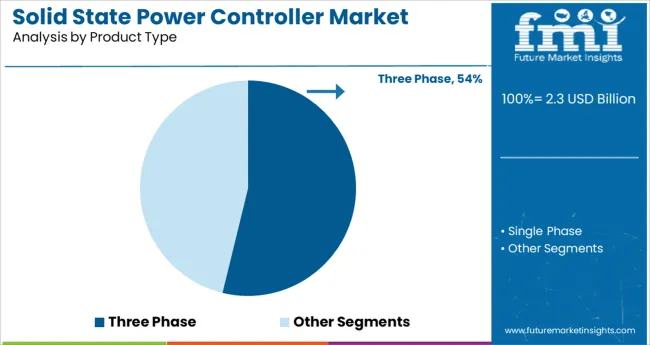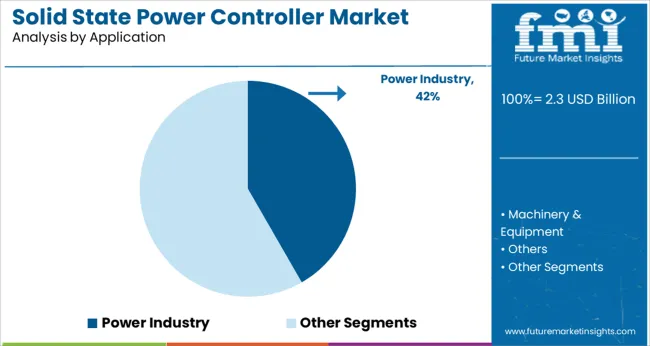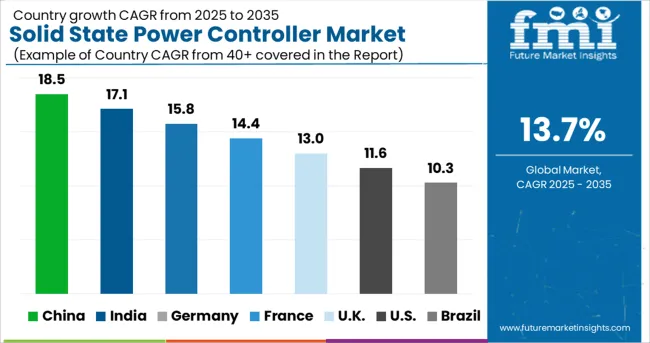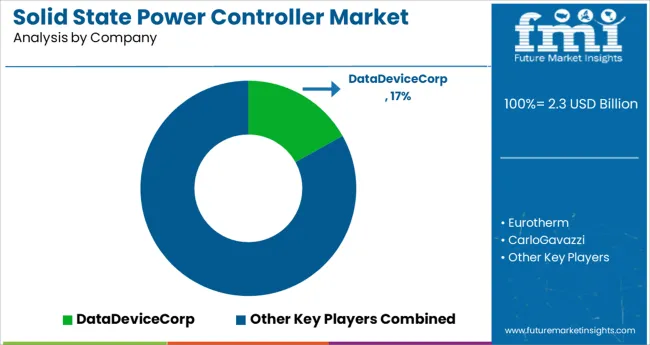The Solid State Power Controller Market is estimated to be valued at USD 2.3 billion in 2025 and is projected to reach USD 8.3 billion by 2035, registering a compound annual growth rate (CAGR) of 13.7% over the forecast period.

The solid state power controller market is undergoing robust expansion as industries modernize their electrical systems with compact, reliable, and digitally managed power control solutions. Increased adoption of electric vehicles, renewable energy integration, and smart grid deployments is driving demand for precise and fault-tolerant power switching equipment.
These controllers offer advantages such as faster response times, reduced electromagnetic interference, and improved durability compared to electromechanical alternatives. Defense, aerospace, and power utility sectors are increasingly deploying solid state units to manage mission-critical loads and enhance energy distribution efficiency.
At the same time, innovations in thermal management, phase control algorithms, and embedded monitoring capabilities are allowing manufacturers to deliver controllers that are both high performance and energy efficient. Future opportunities are expected to emerge from digital retrofitting of legacy systems, standardization of power protocols, and growing emphasis on power system resilience across industrial and commercial sectors.
The market is segmented by Product Type and Application and region. By Product Type, the market is divided into Three Phase and Single Phase. In terms of Application, the market is classified into Power Industry, Machinery & Equipment, and Others. Regionally, the market is classified into North America, Latin America, Western Europe, Eastern Europe, Balkan & Baltic Countries, Russia & Belarus, Central Asia, East Asia, South Asia & Pacific, and the Middle East & Africa.

The three phase segment is projected to account for 53.8% of the solid state power controller market revenue in 2025, making it the dominant product type. This dominance has been supported by the segment’s ability to handle higher power loads with improved efficiency, which is critical in heavy duty and high voltage applications.
Three phase configurations provide balanced power delivery and reduced conductor requirements, which result in lower energy losses and better system performance. These controllers have been widely adopted in defense systems, industrial plants, and aircraft electrical architectures due to their compact size and high reliability under variable load conditions.
As industries move toward electrification and more sophisticated automation, the three phase variant is being favored for its capacity to support large scale systems without compromising on safety or operational stability. The ability to integrate digital diagnostics and real time monitoring within three phase systems has further elevated their role as the preferred architecture in high demand environments.

The power industry application segment is expected to contribute 41.7% of total market revenue in 2025, making it the leading application area. This leadership is driven by the rising need for intelligent load management and rapid fault isolation in energy transmission and distribution networks. Solid state power controllers are being deployed in power substations, grid control systems, and renewable energy arrays to optimize energy flows, prevent overloads, and enhance grid stability.
The transition to decentralized energy systems and the integration of variable renewable sources have created demand for digitally responsive power management devices. In high voltage environments where reliability and response time are paramount, these controllers offer precise switching and improved system safety.
Additionally, regulatory pressure to improve grid efficiency and adopt smart energy infrastructure is compelling utility providers to invest in solid state power control technologies. These dynamics are expected to continue supporting this segment's strong share in the global market.
The rising sales of solid state power controllers can be attributed to the increase in the requirement for energy conservation in manufacturing industries and home utilities to minimize power losses.
In addition to this, the growing need for damage prevention in appliances and equipment due to overvoltage conditions among consumers is projected to facilitate market growth to a considerable extent. Growing awareness among the population is also expected to positively impact the global solid-state controller market outlook.
On the other hand, one of the prime challenges which restrict the growth of the global solid-state power controller market is its high installation cost, complexity in deployment, and lack of standardization.

North America is likely to be at the forefront of the solid state power controller market with a share of 31.8% in 2025 due to the presence of established manufacturing firms and rising demand from end-use industries like machinery & equipment, automotive, and others.
Also, the widespread use of aircraft for commercial, military, and regional purposes in the area also supports the market. Additionally, regional investments in military aircraft are the biggest worldwide, contributing to the region’s market share.
The market for solid-state power controllers is likely to grow at the fastest rate during the forecast period in Europe, with an anticipated solid-state power controller market share of 20.5% in 2025.
The industrialization and modernization taking place in this area are escalating, which is driving up the demand for machinery and appliances that use little energy, in turn propelling the market size on the whole.
Numerous start-ups have been emerging in the solid state power controller market, bringing about recent developments that are shaping the solid-state power controller market's future trends.
Three solid-state drive (SSD) controllers were unveiled by start-up InnoGrit, one of which has a neural network accelerator built-in for data centres. They enter a crowded market with claims of dominance and competitive advantages.
As NAND flash prices appear to be bottoming out, the chips become available.
In order to continue the transition away from hard disc storage in laptops and servers that require performance, power, or size advantages, OEMs and data centres are anticipated to take advantage of the lower prices.

Many companies are putting an emphasis on organic growth strategies, including product approvals, product launches, and others like patents and events.
Acquisitions and partnerships & collaborations are a couple of examples of inorganic growth strategies that are observed in the solid-state power controller market.
These actions have made it possible for market participants to upsurge their clientele and augment the solid-state power controller market share.
With the increasing demand for Aircraft Electrical Solid-State Power Controller (SSPC) in the global market, players in the solid-state power controller market are anticipated to benefit from lucrative growth opportunities in the future.
| Report Attribute | Details |
|---|---|
| Growth Rate | CAGR of 13.7% from 2025 to 2035 |
| Base Year for Estimation | 2024 |
| Historical Data | 2020 to 2024 |
| Forecast Period | 2025 to 2035 |
| Quantitative Units | Revenue in million and CAGR from 2025 to 2035 |
| Report Coverage | Revenue Forecast, Volume Forecast, Company Ranking, Competitive Landscape, Growth Factors, Trends and Pricing Analysis |
| Segments Covered | Product Type, Application, Region |
| Regions Covered | North America; Latin America; Asia Pacific; The Middle East and Africa; Europe |
| Key Countries Profiled | USA, Canada, Brazil, Argentina, Germany, UK, France, Spain, Italy, Nordics, BENELUX, Australia & New Zealand, China, India, ASEAN, GCC, South Africa |
| Key Companies Profiled | Data Device Corp.; Eurotherm; Carlo Gavazzi; Jiangsu Modun Electric; Spang Power Electronics; Teltech; ABB; General Electric; ON Semiconductor; STMicroelectronics; Texas Instruments |
| Customization | Available Upon Request |
The global solid state power controller market is estimated to be valued at USD 2.3 billion in 2025.
It is projected to reach USD 8.3 billion by 2035.
The market is expected to grow at a 13.7% CAGR between 2025 and 2035.
The key product types are three phase and single phase.
power industry segment is expected to dominate with a 41.7% industry share in 2025.






Full Research Suite comprises of:
Market outlook & trends analysis
Interviews & case studies
Strategic recommendations
Vendor profiles & capabilities analysis
5-year forecasts
8 regions and 60+ country-level data splits
Market segment data splits
12 months of continuous data updates
DELIVERED AS:
PDF EXCEL ONLINE
Solid Aluminium Cladding Panel Market Size and Share Forecast Outlook 2025 to 2035
Solid White Films Market Size and Share Forecast Outlook 2025 to 2035
Solid Sulphur Market Size and Share Forecast Outlook 2025 to 2035
Solid Terpene Resin Market Forecast Outlook 2025 to 2035
Solid Phase Carrier Resin for Peptide Drug Synthesis Market Size and Share Forecast Outlook 2025 to 2035
Solid Board Market Size and Share Forecast Outlook 2025 to 2035
Solid Control Equipment Market Size and Share Forecast Outlook 2025 to 2035
Solid Vacuum Reclosers Market Size and Share Forecast Outlook 2025 to 2035
Global Solid Serum Market Size and Share Forecast Outlook 2025 to 2035
Solid Bleached Board Market
Solid Oxide Fuel Cell Market
Solid Electrolyte Market
Solid-State Microwave Source Market Size and Share Forecast Outlook 2025 to 2035
Solid State Relay Market Size and Share Forecast Outlook 2025 to 2035
Solid State Battery Silicon Carbon Negative Electrode Market Size and Share Forecast Outlook 2025 to 2035
Solid-State Array Market Size and Share Forecast Outlook 2025 to 2035
Solid State LiDAR Sensor Market Analysis Size and Share Forecast Outlook 2025 to 2035
Solid-State Lighting Market Size and Share Forecast Outlook 2025 to 2035
Solid State Drive Market Size and Share Forecast Outlook 2025 to 2035
Solid State Lighting System Market Size and Share Forecast Outlook 2025 to 2035

Thank you!
You will receive an email from our Business Development Manager. Please be sure to check your SPAM/JUNK folder too.
Chat With
MaRIA